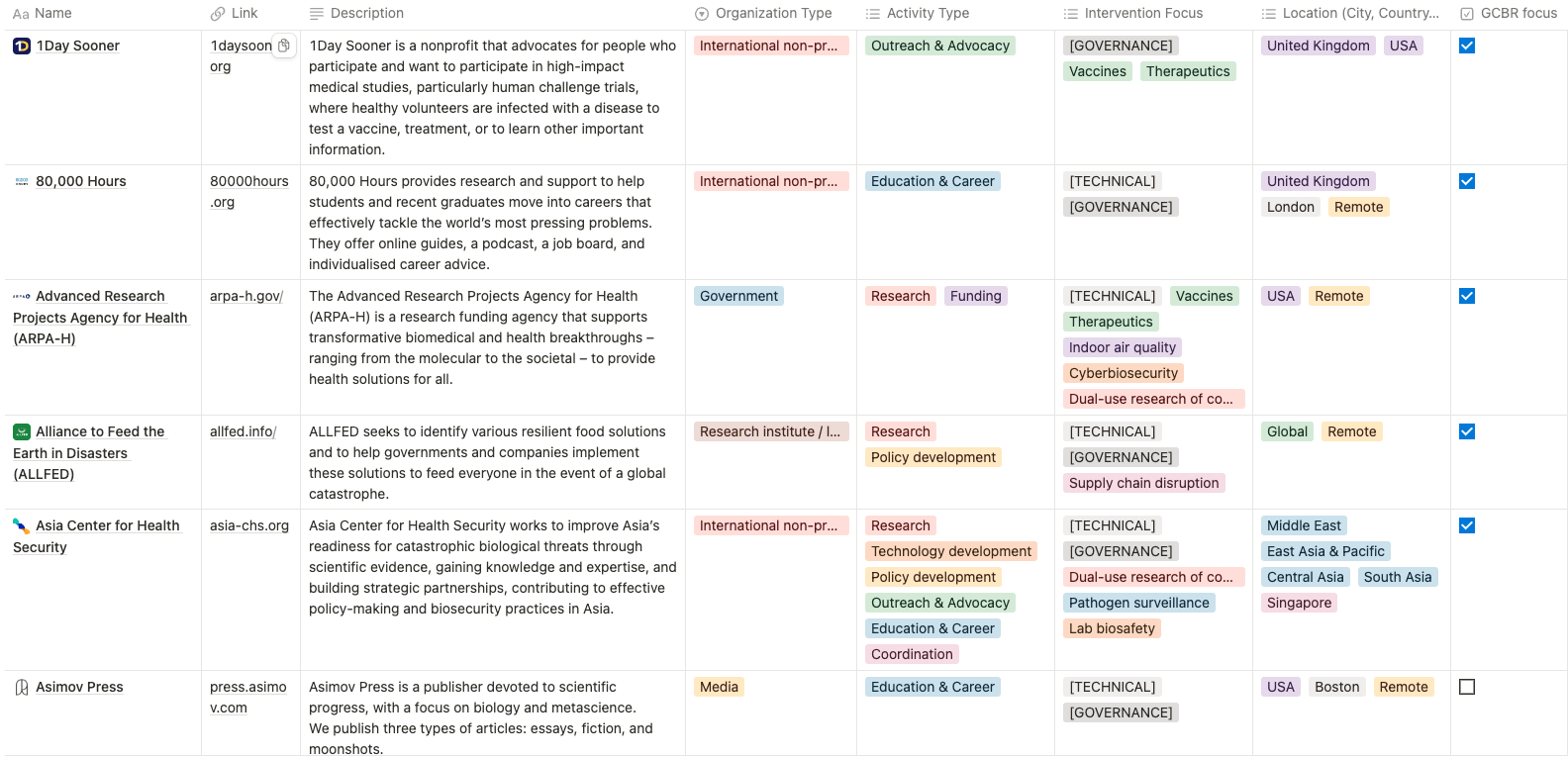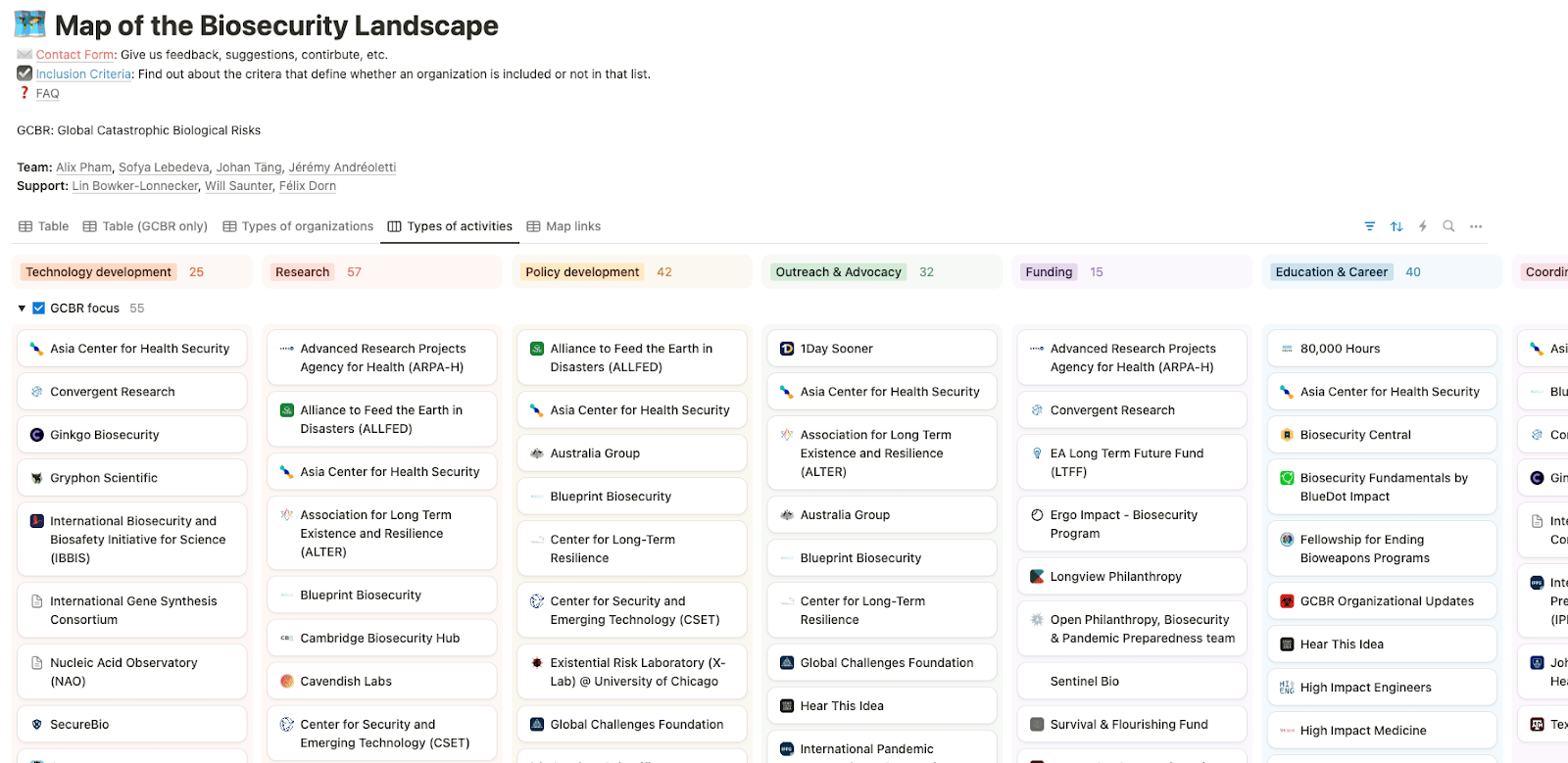We are glad to announce the release of biosecurity.world! Your new go-to website for navigating the biosecurity landscape and finding relevant organizations worldwide.
The biosecurity.world database, in a view structured around the types of activities.
Objective & Target Audience
Our aim is to provide an overview of the biosecurity landscape for people who want to learn more about the field, by giving them an idea of the work that is being done (and by whom) and therefore how they could contribute.
This corresponds to Level 2, and to some extent 3, of this on-ramp model. We got inspiration from aisafety.world.
Current State
This is version 0.2—the Earliest Usable Version.
Thanks to everyone who helped us along the way by providing feedback.
We are currently working on version 0.3—Earliest Lovable—which includes a visualization of the map. We believe the current version is still useful and should be already available.
Navigation
The website has two modes:
- The database mode (hosted on Notion), where you can find:
- In the description at the top:
- A contact form for anything from feedback to suggestions (see Call To Action)
- Our inclusion criteria:
- Upon request, we can make available our inclusion spreadsheet where we evaluate organizations and ultimately make a decision on their inclusion.
- A FAQ, to help users navigate the database
- In the database: a bunch of relevant orgs (120ish at the time of publishing)
- In the description at the top:

- arranged in different table views
- GCBR only: filter via “GCBR focus” to see the most scope-sensitive organizations.
- with the possibility to use additional filters and sorting
- Location: regions are in blue except US and UK in purple, countries in pink, cities in grey; global (green) either means they have multiple locations, or none because they are fully remote (yellow).
- The map mode, which is still in building and will be announced in a future post announcing v0.3.
Call To Action
- Populating: This is still a non-exhaustive list and we are working as fast as we can to populate it and make it accurate. In particular:
- Please suggest anything that we might have missed.
- The database is heavily biased towards the US, and the UK / Europe to a lesser extent, so please help us find other initiatives to make it more exhaustive and inclusive (while meeting the inclusion criteria)
- Additional information would be useful, such as who founded or who runs the organization, when did it start, who funds it, what are their key output (reports, research, products, etc.)
- Experience: Give us feedback on your experience!
- There are many filters: should we have less? Are the categories sensible?
- Overview of the landscape: Can you navigate easily? Does it give you a better understanding of the biosecurity landscape?
- Contributing: We’re a volunteer team and we welcome anyone who wants to help with that project, from maintenance to research, being a point of contact to help users, etc.
You can express interest in the form.
Acknowledgements
- Team: @Alix Pham, @Swan, @Jérémy Andréoletti, @johantang🔸 (authors)
- Support:
- Conceptualization & inclusion criteria: @Lin BL & @Will S
- Map mode & user interviews: Félix Dorn
We'd like to thank everyone who supported that project, from the early conceptualization of the website to the most recent feedback. Special thanks to @Will S and @BlueDot Impact's team for giving the initial structure via the Project Sprint of the Biosecurity Fundamentals course.
Existing Lists and Databases
Biosecurity.world builds on several existing efforts that have cataloged biosecurity organizations, though these efforts have typically been narrower in scope. We aimed to bring these resources together into a more comprehensive and user-friendly database. Below are some of the key sources from which we gathered candidate organizations:
- Databases
- 80,000 Hours (job board, early-career positions)
- Public organizations from EA Orgs • EA Opportunity Board
- BlueDot Impact, Key Biosecurity and Pandemic Preparedness Organizations
- Evan DeTurk, Christian Pearson & Benedikt Thelen, Database of Potential Technical Biosecurity PhD Advisors
- Lists
- GCBR Organizational Updates Newsletter







Thanks for this! We are currently working on a visualization with a volunteer. Let's see how it goes, but we'll definitely keep your offer in mind!
Hamish already shared his code with me, but in the end we decided to go with something else, at least for now.